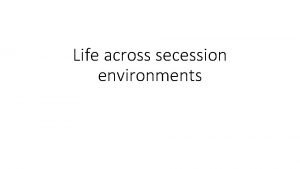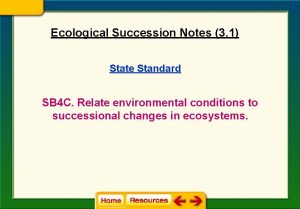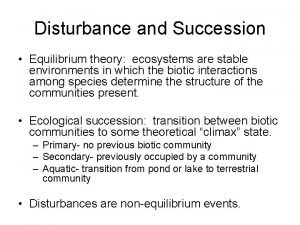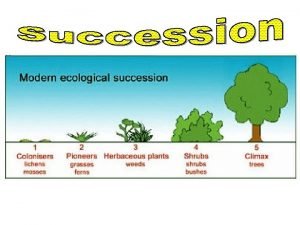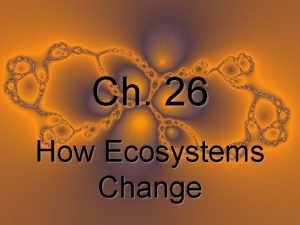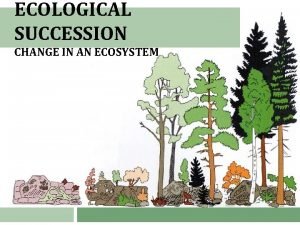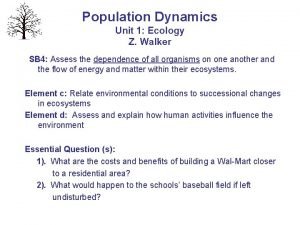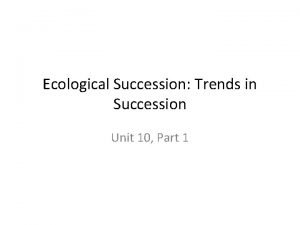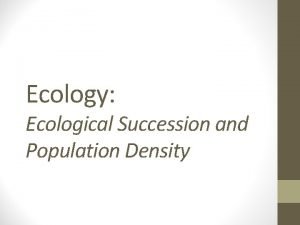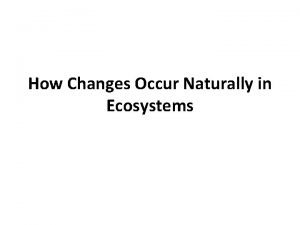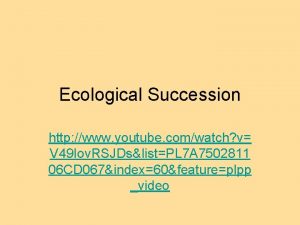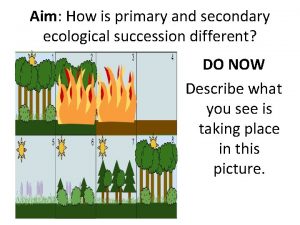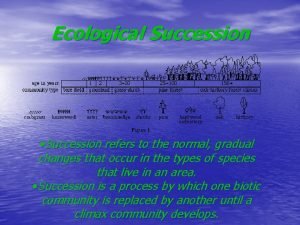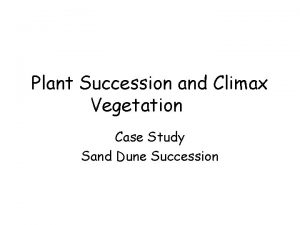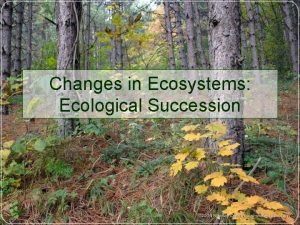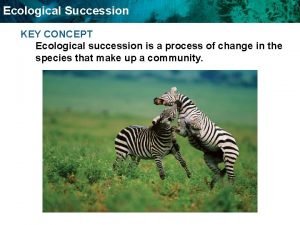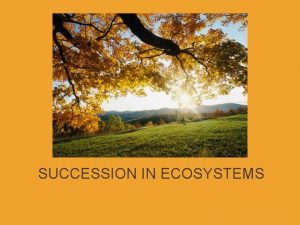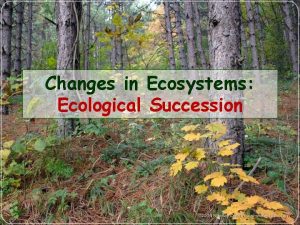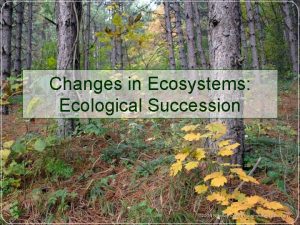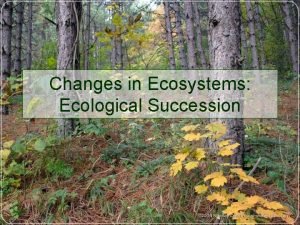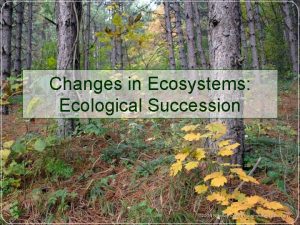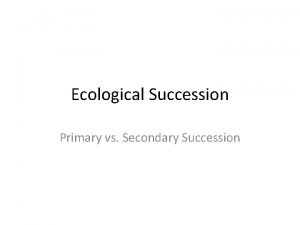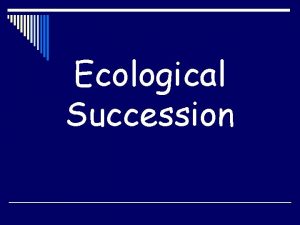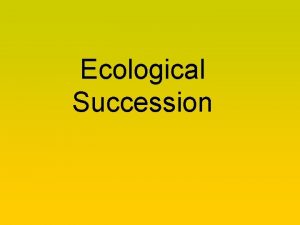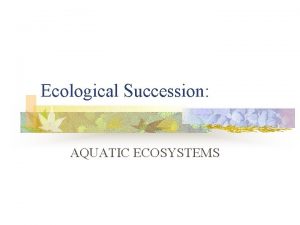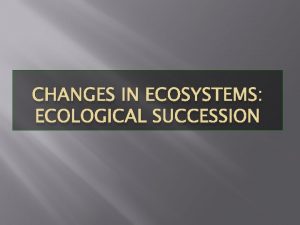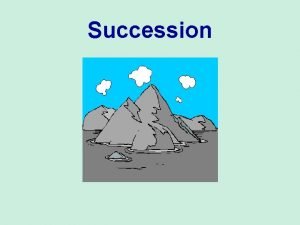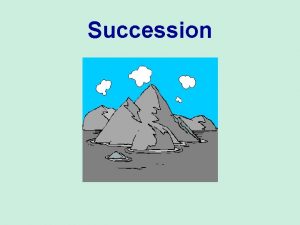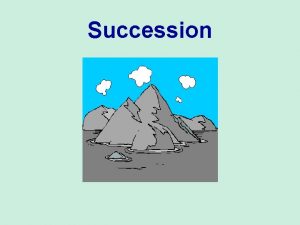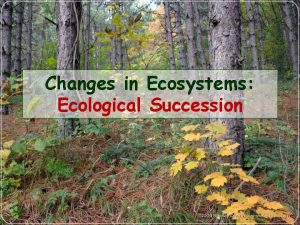Changes in Ecosystems Ecological Succession What is Ecological




















- Slides: 20

Changes in Ecosystems: Ecological Succession

What is Ecological Succession? • Natural, gradual changes in the types of species that live in an area • Can be primary or secondary • The gradual replacement of one plant community by another through natural processes over time

Primary Succession • Begins in a place without any soil: » Sides of volcanoes » Landslides » Flooding • First, lichens that do not need soil to survive grow on rocks • Next, mosses grow to hold newly made soil • Known as PIONEER SPECIES

Pioneer Species Low growing moss plants trap moisture and prevent soil erosion. Lichens break down rock to form soil.

Primary Succession • Soil starts to form as lichens and the forces of weather and erosion help break down rocks into smaller pieces • When lichens die, they decompose, adding small amounts of organic matter to the rock to make soil


Primary Succession • Simple plants like mosses and ferns can grow in the new soil

Primary Succession • The simple plants die, adding more organic material (nutrients to the soil) • The soil layer thickens, and grasses, wildflowers, and other plants begin to take over.

Primary Succession • These plants die and they add more nutrients to the soil. • Shrubs and trees can survive now.

Primary Succession • Insects, small birds, and mammals have begun to move into the area. • What was once bare rock, now supports a variety of life.

Secondary Succession • Begins in a place that already has soil and was once the home of living organisms • Occurs faster and has different pioneer species than primary succession • Example: after forest fires

Ecological Succession Stages of Secondary Succession

Stages of Secondary Succession 1. 2. 3. 4. Annual plants (weeds) Annual and perennial plants and weeds Shrubs Young pine forest 5. Mature pine forest



Ecological Succession • Old-field succession is a type of secondary succession that occurs when farmland is abandoned. • When a farmer stops cultivating a field, grasses and weeds quickly grow and cover the abandoned land. • Over time, taller plants, such as perennial grasses, shrubs, and trees take over the area.

Climax Community • A stable group of plants and animals that is the end result of the succession process • Does not always mean big trees – Grasses in prairies – Cacti in deserts

Write the term or phrase that matches the description. Write the statement and the answer. Circle or highlight your answer 1. a common type of succession that occurs on a surface where an ecosystem has previously existed 2. the first organisms to colonize any newly available area and begin the process of ecological succession 3. a final and stable community 4. a type of succession that occurs on a surface where no ecosystem existed before 5. a type of succession that occurs on abandoned farmland 6. a gradual process of change and replacement of the types of species in a community


 Ecological succession succession of a pond
Ecological succession succession of a pond Ecological succession succession of a pond
Ecological succession succession of a pond Succession definition
Succession definition Succession equilibrium in ecosystems
Succession equilibrium in ecosystems Flow energy review
Flow energy review Ecological succession
Ecological succession Tundra seasons
Tundra seasons Secondary successio
Secondary successio Succession venn diagram
Succession venn diagram Ecological succession
Ecological succession Primary succession
Primary succession Ecological succession
Ecological succession Youtube ecological succession
Youtube ecological succession Homework ecological succession answer key
Homework ecological succession answer key When does a climax community change?
When does a climax community change? Climax stage
Climax stage Primary succession stages
Primary succession stages Secondary succession examples
Secondary succession examples If there is no struggle there is no progress explanation
If there is no struggle there is no progress explanation Succession def
Succession def Def of secondary succession
Def of secondary succession
